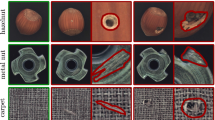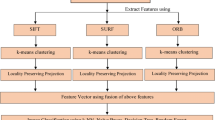Abstract
Several feature-based pattern recognition algorithms have been developed during the past decade. These algorithms rely on identifying keypoints in an image and assigning a descriptor to each point based on the composition of their surrounding region. Comparison of the descriptors of keypoints found in two images enables these algorithms to match similar objects within those images. The dependence of these algorithms’ performance on the similarity of the internal structure of objects makes them susceptible to modifications that change this internal structure. In this paper, we first compare the relative performance of some major feature-based algorithms in finding similar objects surrounded by geometrical noise. Next, we add several noise and transformation types to target objects and re-evaluate the performance of these algorithms under the resulting structural changes. Our results provide insights on the relative strengths of these algorithms in the presence and absence of several noise and transformation types. In addition, these findings allow us to identify modification types that can better inhibit the performance of these algorithms. The resulting insight can be used in applications that need to build resistance against such algorithms, e.g., in developing CAPTCHAs that need to be resistant to recognition attacks.


Similar content being viewed by others
Notes
Scale-invariant feature transform.
Speeded Up Robust Features.
Features from accelerated segment test.
Binary Robust Independent Elementary Features.
Oriented FAST and Rotated BRIEF.
Binary robust invariant scalable keypoints.
Fast retina keypoint.
Many applications do not need rotation invariance; they can use an upright version of SIFT which is faster.
A region around a key point.
Xs are one end and Ys are the other end of the lines.
FAST keypoint orientation.
Rotation-Aware Brief.
The authors stated that BRISK’s method (selecting short-distance pairs as sampling pairs) results in choosing highly correlated pairs.
Fisher’s F-ratio.
References
Bursztein E, Martin M, Mitchell J (2011) Text-based CAPTCHA strengths and weaknesses. Proceedings of the 18th ACM conference on computer and communications security, pp 125–138
Hsieh CC, Wu ZY (2013) Anti-SIFT images based CAPTCHA using versatile characters. International conference on information science and applications (ICISA), pp 1–4
Korayem M, Mohamed AA, Crandall D, Yampolskiy RV (2012) Solving avatar captchas automatically. Adv Machine Learn Technol Appl 322:102–110
Chew M, Baird HS (2003) Baffletext: a human interactive proof. Electronic imaging (International society for optics and photonics), pp 305–316
Grauman K, Leibe B (2011) Visual object recognition. Morgan & Claypool Publishers, San Rafael
Schmid C, Mohr R, Bauckhage C (2000) Evaluation of interest point detectors. Int J Computer Vision 37:151–172
Gauglitz S, Höllerer T (2008) In-depth evaluation of popular interest point detectors on video streams. Practice 2:4
Adam Schmidt MK, Fularz M, Domagala Z (2012) The comparison of point feature detectors and descriptors in the context of robot navigation. Workshop on perception for mobile robots anatomy
Dahl AL, Aanæs H, Pedersen KS (2011) Finding the best feature detector-descriptor combination. Proceedings of international conference on 3D imaging, modeling, processing, visualization and transmission (3DIMPVT), pp 318–325
Lankinen J, Kangas V, Kamarainen JK (2012) A comparison of local feature detectors and descriptors for visual object categorization by intra-class repeatability and matching. Proceedings of 21st international conference on pattern recognition (ICPR), pp 780–783
Miksik O, Mikolajczyk K (2012) Evaluation of local detectors and descriptors for fast feature matching. Proceedings of 21st international conference on pattern recognition (ICPR), pp 2681–2684
Mikolajczyk K, Schmid C (2004) Comparison of affine-invariant local detectors and descriptors. Proceedings of european signal processing conference, pp 1729–1732
Parinda Pandya JS, Kapadia H (2013) Evaluating the object recognition in real-time process. Presented at the 2013 Nirma University international conference on engineering (NUiCONE)
Juan L, Gwun O (2009) A comparison of SIFT, PCA–SIFT and SURF. Int J Image Processing (IJIP) 3:143–152
Mikolajczyk K, Schmid C (2005) A performance evaluation of local descriptors. IEEE Trans Pattern Analysis and Machine Intelligence 27:1615–1630
Moreels P, Perona P (2007) Evaluation of features detectors and descriptors based on 3D objects. Int J Computer Vision 73:263–284
Gauglitz S, Höllerer T, Turk M (2011) Evaluation of interest point detectors and feature descriptors for visual tracking. Int J Computer Vision 94:335–360
McCafferty JD (1990) Human and machine vision: computing perceptual organisation. Ellis Horwood in Digital and Signal Processing, Ellis Horwood
Lowe DG (2004) Distinctive image features from scale-invariant keypoints. Int J Computer Vision 60:91–110
Rosten E, Drummond T (2006) Machine learning for high-speed corner detection. Computer vision–ECCV 3951:430–443
Treiber M (2010) An introduction to object recognition: Selected algorithms for a wide variety of applications. Springer-Verlag, London
Bay H, Ess A, Tuytelaars T, Van Gool L (2008) Speeded-up robust features (SURF). J Computer vision and image understanding 110:346–359
Calonder M, Lepetit V, Strecha C, Fua P (2010) Brief: binary robust independent elementary features. Computer vision–ECCV, pp 778–792
Rublee E, Rabaud V, Konolige K, Bradski G (2011) ORB: an efficient alternative to SIFT or SURF. Proceedings of IEEE international conference on computer vision (ICCV), pp 2564–2571
Leutenegger S, Chli M, Siegwart RY (2011) BRISK: Binary robust invariant scalable keypoints. Proceedings of IEEE international conference on computer vision (ICCV), pp 2548–2555
Alahi A, Ortiz R, Vandergheynst P (2012) Freak: Fast retina keypoint. Proceedings of IEEE conference on computer vision and pattern recognition (CVPR), pp 510–517
Fischler MA, Bolles RC (1981) Random sample consensus: a paradigm for model fitting with applications to image analysis and automated cartography. J Communications of the ACM 24:381–395
Roshanbin N, Miller J (2016) ADAMAS: interweaving unicode and color to enhance CAPTCHA security. J Future Generation Computer Systems 55:289–310
Acknowledgments
This research is supported by NSERC (Natural Sciences and Engineering Research Council of Canada) and AITF (Alberta Innovates Technology Futures).
Author information
Authors and Affiliations
Corresponding author
Rights and permissions
About this article
Cite this article
Roshanbin, N., Miller, J. A comparative study of the performance of local feature-based pattern recognition algorithms. Pattern Anal Applic 20, 1145–1156 (2017). https://doi.org/10.1007/s10044-016-0554-y
Received:
Accepted:
Published:
Issue Date:
DOI: https://doi.org/10.1007/s10044-016-0554-y




